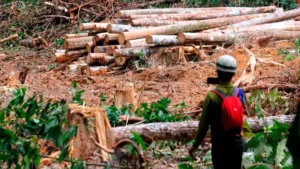Benefits of Nature Restoration: A New Series of Policy Briefs
- September 5, 2024
- 0 comment
Nature restoration, an essential practice in environmental conservation, seeks to revive and sustain ecosystems that have been degraded, damaged, or destroyed. This vital work is at the heart of global efforts to address the twin crises of biodiversity loss and climate change. Policy plays a critical role in steering these restoration efforts, providing the framework for action, and ensuring that initiatives are well-coordinated, adequately funded, and effectively implemented.

In recognition of the importance of nature restoration, a new series of policy briefs has been released, shedding light on the multifaceted benefits that such efforts bring. These briefs aim to inform policymakers, stakeholders, and the general public about the economic, social, and environmental advantages of restoring natural habitats, while also offering strategic recommendations for successful implementation.
The Concept of Nature Restoration
Nature restoration encompasses a wide range of activities aimed at repairing the ecological balance of areas affected by human activities or natural disasters. It involves the re-establishment of native species, the rehabilitation of ecosystem services, and the enhancement of natural processes to ensure long-term sustainability.
Historically, nature restoration has evolved from small-scale, community-led projects to large-scale, government-supported initiatives, reflecting the growing recognition of its importance in maintaining ecological integrity. Today, nature restoration is seen not just as an environmental necessity but also as a critical component of sustainable development.
Why Nature Restoration is Crucial
Nature restoration is crucial for several reasons, each linked to broader environmental, social, and economic goals:
- Biodiversity Conservation: Restoring natural habitats helps to protect and enhance biodiversity, providing essential habitats for endangered and threatened species. This is vital for maintaining the health and resilience of ecosystems.
- Ecosystem Services Enhancement: Ecosystems provide a range of services, from clean air and water to pollination and soil fertility. Restoring these ecosystems ensures that these services continue to benefit humanity.
- Climate Change Mitigation: Nature restoration plays a significant role in climate change mitigation by sequestering carbon, restoring natural water cycles, and reducing the impact of extreme weather events.
1. Economic Benefits of Nature Restoration
One of the most compelling arguments for nature restoration is its potential to generate significant economic benefits:

- Job Creation and Economic Growth: Restoration projects often require substantial labor, creating jobs in rural and urban areas. These jobs range from manual labor to scientific research and project management, contributing to local economies.
- Sustainable Development Opportunities: By restoring natural habitats, communities can develop sustainable tourism, agriculture, and forestry practices that are less damaging to the environment, ensuring long-term economic viability.
Moreover, healthy ecosystems can reduce the cost of natural disasters by acting as buffers against floods, storms, and other extreme weather events, thereby saving billions in potential damages.
2. Social Benefits of Nature Restoration
Nature restoration has profound social benefits, particularly in improving public health and fostering community engagement:

- Health and Well-being Improvements: Access to restored natural areas promotes physical and mental well-being. Studies have shown that time spent in nature can reduce stress, improve mood, and enhance overall health, making it a crucial public health resource.
- Community Engagement and Social Cohesion: Restoration projects often involve local communities, providing opportunities for engagement, education, and collaboration. This can strengthen social bonds, foster a sense of ownership, and empower communities to take an active role in conservation efforts.
These social benefits are particularly important in urban areas, where green spaces are limited and the health impacts of nature can be most keenly felt.
3. Environmental Benefits of Nature Restoration
The environmental benefits of nature restoration are extensive and vital for sustaining life on Earth:
- Improved Ecosystem Health: Restoration efforts help to revitalize ecosystems, ensuring they can function effectively and support a wide range of species.
- Enhanced Biodiversity: By restoring habitats, nature restoration projects contribute to the conservation of species diversity, which is critical for the resilience and stability of ecosystems.
- Resilience to Environmental Stressors: Healthy ecosystems are better equipped to withstand and recover from environmental stressors such as pollution, climate change, and habitat fragmentation. This resilience is essential for maintaining ecosystem services that humans rely on.
4. Policy Recommendations from the Briefs
The policy briefs provide several strategic recommendations for implementing effective nature restoration efforts:
- Strategic Approaches: Governments are encouraged to adopt a landscape-scale approach to restoration, integrating restoration efforts into broader land-use planning and development strategies.
- Policy Integration and Coordination: Effective nature restoration requires coordination across various policy areas, including agriculture, forestry, urban planning, and water management. The briefs advocate for integrated policies that align restoration goals with broader socio-economic objectives.
- Incentives for Restoration: To encourage private sector participation, the briefs recommend the use of economic incentives, such as tax breaks, grants, and subsidies for restoration activities.
5. Case Studies and Examples
Several successful nature restoration projects illustrate the potential benefits and challenges of these efforts:
- The Great Green Wall Initiative in Africa: This ambitious project aims to restore 100 million hectares of degraded land across the Sahel region, providing a vital barrier against desertification while enhancing food security and livelihoods.
- Wetland Restoration in Europe: Wetland restoration projects across Europe have successfully revived important ecosystems, supporting biodiversity, improving water quality, and enhancing flood control.
Below is a calculation table summarizing key aspects of the case studies and examples related to nature restoration. The table provides a concise overview of each project, including the area restored, key benefits, and economic impacts.
| Case Study/Project | Location | Area Restored | Key Benefits | Economic Impact |
|---|---|---|---|---|
| The Great Green Wall Initiative | Sahel Region, Africa | 100 million hectares | – Combat desertification – Enhance food security – Boost biodiversity | – Creates thousands of jobs – Supports agriculture and local economies |
| Wetland Restoration in Europe | Various European countries | 1.5 million hectares | – Improve water quality – Flood control – Support wildlife habitats | – Reduces flood-related costs – Promotes eco-tourism |
| Loess Plateau Watershed Rehabilitation | China | 35,000 square kilometers | – Soil erosion control – Increase agricultural productivity | – Increased income for 2.5 million people – Agricultural yield improvement by 60% |
| The Atlantic Forest Restoration Pact | Brazil | 15 million hectares (by 2050) | – Restore biodiversity – Carbon sequestration – Water cycle restoration | – Potential carbon market benefits – Boosts sustainable agriculture |
| Prairie Restoration in the U.S. Midwest | United States (Midwest) | 500,000 acres | – Habitat restoration for pollinators – Soil health improvement | – Enhances agricultural resilience – Supports renewable energy projects (e.g., wind farms) |
Explanation:
- The Great Green Wall Initiative: This large-scale project aims to restore degraded land across the Sahel region, contributing to economic resilience through job creation and enhanced agricultural productivity.
- Wetland Restoration in Europe: Wetlands across Europe have been restored to improve water quality and provide natural flood defenses, reducing economic costs associated with flooding while supporting eco-tourism.
- Loess Plateau Watershed Rehabilitation: This project in China successfully controlled soil erosion and increased agricultural productivity, significantly boosting the incomes of local farmers.
- The Atlantic Forest Restoration Pact: This Brazilian initiative focuses on restoring vast areas of the Atlantic Forest, with projected benefits in carbon sequestration and sustainable agriculture, potentially providing economic gains through carbon markets.
- Prairie Restoration in the U.S. Midwest: Prairie restoration efforts are vital for maintaining soil health and supporting biodiversity, with economic benefits tied to enhanced agricultural practices and renewable energy projects.
These case studies highlight the importance of tailoring restoration efforts to local conditions and ensuring sustained funding and community involvement.
6. Challenges and Barriers to Implementation
Despite the many benefits of nature restoration, several challenges hinder its widespread implementation:
- Financial and Resource Constraints: Restoration projects can be costly, requiring significant upfront investment and long-term funding. Limited financial resources often hamper the scope and scale of restoration efforts.
- Political and Institutional Barriers: Political will and institutional capacity are critical for successful restoration. In some cases, lack of political support, bureaucratic inertia, and competing land-use priorities can obstruct restoration initiatives.
Overcoming these challenges requires strong leadership, innovative funding mechanisms, and sustained advocacy to keep nature restoration high on the policy agenda.
7. Role of Stakeholders in Nature Restoration
The success of nature restoration efforts depends on the active involvement of a wide range of stakeholders:
| Stakeholder Group | Primary Role | Key Contributions | Potential Economic Impact |
|---|---|---|---|
| Government and Policy Makers | – Regulatory and policy framework | – Legislation and policy development – Funding allocation – Setting national restoration targets | – Attracts investment through stable policies – Reduces costs of environmental degradation |
| Non-Governmental Organizations (NGOs) | – Advocacy and implementation | – Project management – Community mobilization – Monitoring and reporting | – Secures funding from international donors – Boosts local economies through project implementation |
| Private Sector | – Investment and innovation | – Funding for restoration projects – Development of green technologies – Corporate social responsibility (CSR) initiatives | – Drives innovation in sustainable practices – Enhances brand value and market competitiveness |
| Local Communities | – On-the-ground implementation | – Participatory restoration efforts – Traditional ecological knowledge – Maintenance of restored areas | – Improves local livelihoods through sustainable resource use – Increases local economic activity |
| Academic and Research Institutions | – Research and development | – Scientific research – Development of restoration techniques – Training and education programs | – Supports evidence-based policymaking – Facilitates technology transfer and innovation |
| International Organizations | – Global coordination and funding | – International collaboration – Technical assistance – Setting global standards and targets | – Mobilizes global funding and expertise – Encourages cross-border restoration projects |
- Government and Policy Makers: Governments play a central role in providing the legal and regulatory framework for restoration. They are responsible for setting targets, allocating resources, and ensuring that restoration efforts are aligned with national and international commitments.
- Non-Governmental Organizations (NGOs): NGOs are often at the forefront of restoration efforts, providing expertise, mobilizing resources, and advocating for policies that support restoration goals.
- Private Sector: The private sector can contribute through corporate social responsibility initiatives, sustainable business practices, and investments in restoration projects.
The Future of Nature Restoration Policies
As the global recognition of the importance of nature restoration grows, so too does the need for innovative policies that can address emerging challenges:
- Emerging Trends and Innovations: Advances in restoration science, such as the use of technology for monitoring and evaluating restoration projects, are enhancing the effectiveness of restoration efforts.
- Long-term Vision and Goals: Achieving long-term restoration goals requires a sustained commitment to maintaining restored areas and ensuring that they continue to provide ecosystem services.
Importance of Monitoring and Evaluation
Effective monitoring and evaluation are crucial for ensuring the success of nature restoration projects:
- Tracking Progress and Outcomes: Regular monitoring allows for the assessment of restoration progress, helping to identify successful strategies and areas needing improvement.
- Adaptive Management Strategies: By incorporating feedback from monitoring efforts, restoration projects can be adjusted and improved over time, ensuring that they meet their objectives.
Public Awareness and Education
Raising public awareness and educating communities about the importance of nature restoration is essential for garnering support and participation:
- Raising Awareness through Media and Campaigns: Public campaigns and media coverage can help to highlight the benefits of restoration, motivating individuals and organizations to get involved.
- Role of Education in Promoting Restoration Efforts: Educational programs, from schools to community workshops, play a crucial role in building a culture of conservation and empowering future generations to take action.
Final Conclusion
The benefits of nature restoration are vast, encompassing economic, social, and environmental dimensions. The new series of policy briefs offers a timely and valuable resource for policymakers and stakeholders, providing clear guidance on how to harness these benefits and overcome the challenges of restoration.
As the world faces increasing environmental pressures, the need for effective nature restoration policies has never been greater. By implementing the recommendations outlined in these briefs, governments and organizations can play a pivotal role in restoring the planet’s ecosystems and securing a sustainable future for all.
Frequently Asked Questions (FAQs)
- What is Nature Restoration?
Nature restoration involves efforts to repair ecosystems that have been degraded, damaged, or destroyed, aiming to bring them back to their natural state. - How does it benefit the economy?
Nature restoration creates jobs, boosts local economies through sustainable practices, and reduces the costs associated with natural disasters. - What challenges does it face?
Challenges include financial constraints, political and institutional barriers, and the need for sustained public and stakeholder engagement. - How can communities get involved?
Communities can participate in local restoration projects, advocate for supportive policies, and raise awareness about the importance of restoration. - What role does technology play in restoration?
Technology aids in monitoring and evaluating restoration efforts, providing data that helps to track progress and guide adaptive management strategies. - Why is public awareness important?
Public awareness is crucial for garnering support for restoration efforts and ensuring that individuals and organizations understand the value of healthy ecosystems.

James Wilson
Forestry AuthorJames Wilson has over 15 years of experience in forestry economics, specializing in sustainable practices, investment opportunities, and financial management. He has contributed to notable publications like "Forestry Today" and "EcoFinance Journal" and is known for providing practical and insightful advice. With a degree in Environmental Economics, James stays updated through continuous learning and active participation in industry discussions. Outside work, he enjoys hiking and nature photography, bringing a well-rounded perspective to his professional role.








Leave your comment